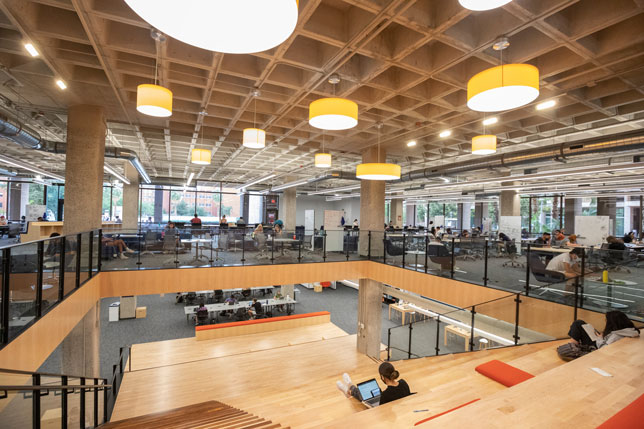New U Arizona Student Success District Brings Together Services and Support

University of Arizona's Main Library, part of the new Student Success District (photo courtesy of University of Arizona)
The University of Arizona has created a new Student Success District that consolidates a variety of resources for students, including library services, learning support, tutoring, advising, mentoring, career services and health programs, in one central location. Spanning 9 acres, the district comprises four interconnected main buildings: the Main Library, Albert B. Weaver Science-Engineering Library, Bear Down Building and the newly constructed Bartlett Academic Success Center.
Plans for the new district began in 2015 as part of an extensive building renovation and construction project, with the design process informed by input from students, faculty, staff and architects. The goal was to provide seamless access to academic resources, collaboration spaces, health and wellness support and more. Among the new spaces are:
- The Main Library offers creative spaces, individual quiet study rooms and digital technologies for collaborative and individual learning, accessible by students from all disciplines. In particular, the newly established CATalyst Studios — a maker studio, virtual reality studio, media recording studio and data studio — offer spaces where students can engage with 3D printing, virtual reality, computational research tools and other technologies. The library also houses IT support resources and a Tech Toolshed where students can borrow a range of technologies, from laptops and tablets to maker tools and VR kits.
- The Albert B. Weaver Science-Engineering Library provides technology-rich spaces for teaching and learning, including the university's first collaborative learning classroom, a 270-student space designed with flexible seating and technologies for active learning. Other study rooms and spaces include a learning studio for instruction, computer study areas and a family study room for students with children.
- The historic Bear Down Building, formerly known as the Bear Down Gymnasium, houses spaces for academic support programs, career coaching, reservable study rooms, a Campus Health office and a new Campus Recreation location with a large fitness, room, community clubhouse, cabanas and more.
- The Bartlett Academic Success Center features advising services, a Student Engagement & Career Development office and Student Success & Retention Innovation programs.
- Outdoor patios and walkways between the buildings provide spaces for collaboration, meditation and more.
"The renovation and construction of these buildings is an implementation of our strategy to adapt to the future needs of our students and our state, from recruitment and initial enrollment to timely graduation and a course to achieve their hopes and dreams and go out and make the world a better place," said University of Arizona President Robert C. Robbins. "I am incredibly grateful for our donors and all of you who are here who supported this initiative, and our incredible faculty, staff and students who have worked tirelessly to make this vision come to life."
"There was no preexisting prototype or template for the Student Success District," added Shan Sutton, dean of University Libraries. "Instead, we created it from our own collective vision for optimizing the UA student experience with an emphasis on the whole student and every single student at the U of A. And we dreamed at a scale you just won't find at any other university with this project."
About the Author
Rhea Kelly is editor in chief for Campus Technology, THE Journal, and Spaces4Learning. She can be reached at [email protected].